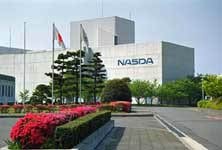
The National Space Development Agency of Japan (NASDA) was established on October 1 , 1969, under the National Space Development Agency Law, to act as the nucleus for the development of space and promote the peaceful use of space.
NASDA was responsible for based on the Japanese Space Development Program enacted by the Minister of Education,Culture,Sports,Science and Technology(MEXT):
- Development of satellites (including space experiments and the space station) and launch vehicles, launching and tracking the craft.
- Development of methods, facilities and equipment required for the above.
| 2003 | Mar. | Information-gathering Satellite was launched by H-IIA Launch Vehicle No.5. |
| 2002 | Dec. | "MIDORI II" Advanced Earth Observation Satellite-II (ADEOS-II) and three micro satellites(FedSAT (CSIRO), Micro-Lab Sat (NASDA), WEOS(CIT)) were launched by H-IIA Launch Vehicle No.4. |
| Sep. | "Kodama" Data Relay Test Satellite (DRTS) and Unmanned Space Experiment Recovery System (USERS) were launched by H-IIA Launch Vehicle No.3. | |
| Feb. | The Mission Demonstration Test Satellite-1 (MDS-1) and the Demonstrator of Atmospheric Reentry System with Hyper Velocity (DASH) were launched by H-IIA Launch Vehicle No.2. | |
| 2001 | Aug. | Launch of H-IIA Launch Vehicle No.1. The Laser Ranging Equipment (LRE) was successfully separated. |
| Jan. | Placed under the jurisdiction of the Ministry of Education, Culture, Sports, Science and Technology following a reorganization of government ministries | |
| 2000 | Feb. | Earth Observation by SRTM of STS-99 Mission. |
| 1999 | Nov. | Failure of launch of the H-II Launch Vehicle No.8. |
| Feb. | Three astronaut candidates were selected. | |
| 1998 | Oct. | Life science experiments were conducted on STS-95 mission. |
| Feb. | Communications and Broadcasting Engineering Test Satellite (COMETS) was launched by H-II launch vehicle No.5. * The injection into orbit failed due to a malfunction in the second stage engine |
|
| 1997 | Nov. | Astronaut Takao Doi performed Japan's first spacewalk on STS-87. Engineering Test Satellite-VII (ETS-VII) "ORIHIME HIKOBOSHI" and Tropical Rainfall Measuring Mission (TRMM) were launched by H-II launch vehicle No.6. |
| 1996 | Aug. | Advanced Earth Observing Satellite (ADEOS), "Midori", and the Japan Amateur Satellite (JAS-2), "Fuji-3", were launched by H-II launch vehicle No.4. |
| Jul.-Aug. | Automatic Landing Flight Exepriment (ALFLEX) was conducted 13 times. | |
| May. | An astronaut was selected. | |
| Feb. | Launch of the Hypersonic Flight Experiment (HYFLEX) by J-I rocket No.1. | |
| Jan. | The SFU was retrieved by the Space Shuttle Endeavour (STS-72). | |
| 1995 | Mar. | Launch of Space Flyer Unit (SFU) and Geostationary Meteorological Satellite-5 "Himawari-5" by H-II launch vehicle No.3 |
| 1994 | Aug. | Launch of Engineering Test Satellite "Kiku-6" by H-II launch vehicle No.2 * The injection into orbit failed due to a malfunction in the apogee-engine). |
| Jul. | Operation of the Second International Microgravity Laboratory Mission. | |
| Feb. | Start of H-II launch series with launch of Orbital Re-Entry Experiment "Ryusei" and Vehicle Evaluation Payload "Myojo" by H-II | |
| 1993 | Apr. | Start of J-I rocket development |
| 1992 | Oct. | Selection of Japanese payload specialist for Second Microgravity Laboratory Mission. |
| Sep. | First Material Processing Test for "Fuwatto '92" aboard the U.S. Space Shuttle. | |
| Apr. | Selection of astronaut (Mission Specialist). | |
| Feb. | Completion of H-I launch series ( total of 9 satellites launched ). | |
| 1991 | Jul. | Start of selection process for Japanese astronaut. |
| 1990 | Apr. | Selection of the prime payload specialist for the U.S. Space Shuttle. First Material Processing Test for "Fuwatto '91." |
| 1989 | Jun. | Approval of IGA by the National Diet of Japan. |
| 1988 | Completion of the static firing test facility for the LE-7 engine of the H-II rockets at Tanegashima Space Center. | |
| Sep. | Signing of Intergovernmental Agreement (IGA), framework for the design, development, operation and utilization of the Space Station, by Japan, the United States, European contries and Canada. | |
| 1987 | Feb. | Completion of N-II launch series ( total of 8 satellites launched ). |
| 1986 | Aug. | Start of H-I launch series. |
| Start of H-II rocket development. | ||
| 1985 | Aug. | Selection of three Japanese payload specialists for U.S. Space Shuttle. Start of Space Station preliminary design. |
| Start of construction for a H-II rocket launch facility at Tanegashima Space Center. | ||
| 1982 | Building of facility for launching H-I rockets at Tanegashima Space Center. | |
| Sep. | Completion of N-I launch vehicle operations ( a total of 7 satellites launched). | |
| 1981 | Start of H-I launch vehicle development. | |
| Feb. | Start of N-II launch series. | |
| 1980 | Jul. | Establishment of Kakuda Propulsion Center. |
| 1979 | Aug. | Opening of Space Museum at Tanegashima Space Center |
| 1978 | Oct. | Establishment of Earth Observation Center. |
| 1977 | Feb. | Launch of Engineering Test Satellite "Kiku-2"(Japan's first geostationary satellite) by N-I rocket No.3. |
| 1976 | Oct. | Start of N-II launch vehicle development. |
| 1975 | Sep. | Start of N-I launch series with the launch of Engineering Test Satellite "Kiku-1". |
| 1972 | Jun. | Establishment of Tsukuba Space Center. |
| 1970 | Oct. | Start of N-I launch vehicle development. |
| 1969 | Oct. | NASDA established with Headquarters, Tanegashima Space Center, Kodaira and Mitaka Branches, and Katsuura and Okinawa tracking stations. |
| Jun. | Approved of Law establishing the National Space Development Agency of Japan approved by the 61st session of the National Diet. |